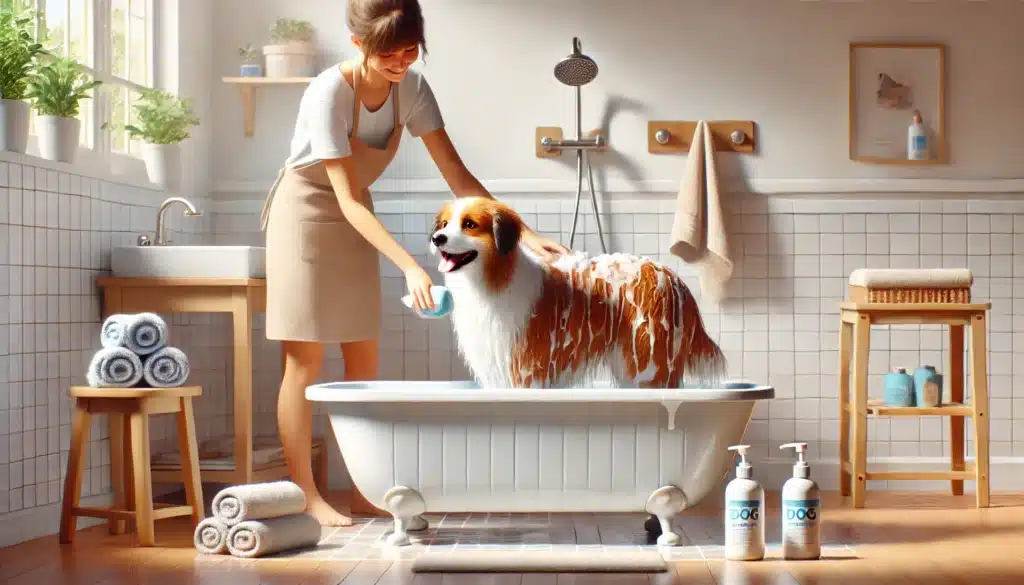Bathing your dog at home can seem like a messy, stressful chore — for both you and your pet. But with the right approach, it can become a smooth and even enjoyable part of your dog’s grooming routine. Whether you have a small, fluffy lapdog or a large, adventurous breed, knowing how to bathe your dog properly is essential for their health and comfort.
In this article, you’ll learn the step-by-step process, the best products to use, how often to bathe, and tips for making bath time easier and safer.
Why Regular Baths Matter
Bathing your dog isn’t just about keeping them clean and smelling good. It helps:
- Remove dirt, allergens, and loose fur
- Prevent skin issues like itching or infections
- Keep their coat shiny and healthy
- Control odors caused by bacteria or buildup
- Build trust and strengthen your bond with your dog
However, too much bathing can strip the natural oils from your dog’s skin, leading to dryness and irritation. That’s why it’s important to find the right balance.
How Often Should You Bathe Your Dog?
There’s no one-size-fits-all rule. Frequency depends on factors like:
- Breed type: Dogs with oily coats (like Basset Hounds) may need more frequent baths. Breeds with double coats (like Huskies) need fewer baths but more brushing.
- Activity level: Active dogs that love rolling in mud will obviously need more baths.
- Skin conditions: Some dogs require medicated baths as recommended by a vet.
- Living environment: Indoor dogs usually stay cleaner longer than outdoor dogs.
As a general rule:
➡️ Once every 4 to 6 weeks is sufficient for most dogs.
What You’ll Need Before You Start
Gathering the right supplies ahead of time makes the process much easier:
- Dog shampoo (never use human shampoo)
- Towels — more than one
- A cup or a gentle spray nozzle
- A non-slip mat for the tub or shower
- A brush for pre- and post-bath grooming
- Cotton balls (to protect ears)
- A blow dryer (optional, must be dog-safe)
Optional but helpful:
- Treats for positive reinforcement
- A grooming apron for yourself
- Conditioner (for dogs with long coats or dry skin)
Step-by-Step: Bathing Your Dog at Home
1. Brush Your Dog First
Before you even turn on the water, give your dog a thorough brush. This helps:
- Remove mats or tangles (which worsen with water)
- Get rid of loose fur
- Reduce shedding during the bath
- Help your dog relax
2. Choose the Right Location
Depending on your dog’s size and your home setup, you might use:
- A bathtub
- A walk-in shower
- A laundry sink (for small dogs)
- Outdoors with a hose (only in warm weather)
Make sure the surface is non-slip and the water is lukewarm — not too hot, not too cold.
3. Prepare Your Dog
Put cotton balls gently into your dog’s ears to prevent water from getting in (don’t push them deep). Use a calm voice and let your dog sniff around the bathing area.
If your dog is nervous, try using treats or toys for distraction.
4. Wet Your Dog Thoroughly
Use a cup or spray nozzle to wet your dog, starting from the neck down. Avoid the eyes, ears, and nose. Make sure the coat is completely soaked before applying shampoo.
5. Lather Up
Use a dog-specific shampoo and work it into the coat with your hands. Massage the skin gently and focus on areas that get dirty quickly: paws, belly, tail, and underarms.
Let the shampoo sit for a minute or two before rinsing.
6. Rinse Thoroughly
Leftover shampoo can irritate your dog’s skin. Rinse until the water runs clear and make sure no residue remains, especially in thick coats.
7. Optional: Conditioner
If your dog has dry skin or a long, thick coat, apply a conditioner made for dogs. Leave it on for the recommended time and rinse thoroughly again.
8. Drying Off
- Towel dry: Use absorbent towels to blot and gently rub. You’ll probably need more than one.
- Blow dry: Use a dog-safe dryer on a low heat setting, keeping it at a distance. Never use a hot setting.
- Air dry: Only for warm, draft-free environments.
Always keep your dog indoors until they’re fully dry to prevent chills or skin issues.
Tips for a Stress-Free Experience
- Start young: If possible, get your dog used to baths as a puppy.
- Keep calm: Your energy affects your dog’s behavior. Stay positive and reassuring.
- Use praise: Reward good behavior with treats and affection.
- Don’t rush: Give your dog time to adjust, especially if they’re nervous.
- Keep sessions short: Especially at first, don’t make the bath too long.
- Use a helper: If your dog is large or wiggly, having a second person can help.
Mistakes to Avoid
- Using human shampoo (can irritate dog skin)
- Getting water in the ears or eyes
- Skipping the rinse — leftover shampoo causes irritation
- Bathing too often
- Not drying properly, especially in cold weather
- Not brushing before the bath
When to Seek Professional Help
Consider taking your dog to a professional groomer if:
- They have a very thick or matted coat
- They’re aggressive or highly anxious
- You need breed-specific grooming (like trimming for Poodles or Schnauzers)
- Your dog needs a medicated bath for a skin condition
Groomers have tools and experience to make bath time quicker and safer — and sometimes, it’s worth every penny.
Final Thoughts: Making Bath Time a Bonding Time
Bathing your dog at home doesn’t have to be a dreaded task. With preparation, patience, and positive reinforcement, you can turn it into a bonding experience that strengthens your relationship with your furry friend.
Over time, your dog may even begin to enjoy the process — or at least tolerate it without a fuss. And you’ll feel good knowing you’re doing something important for their health and happiness.







